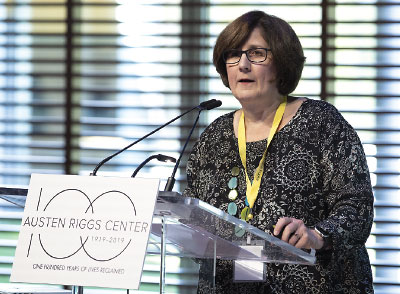Four R’s Believed to Be Protective Against Suicide
Abstract
Suicide is more than a mental health crisis—it reflects socio-cultural and public policy crises.
Relationships, resilience, and reasons for living—those are key variables protective against suicide, said Jane Tillman, Ph.D., director of the Erikson Institute for Education and Research at Austen Riggs Center.

Jane Tillman, Ph.D., says that Extreme Risk Protection Orders for individuals deemed at risk for suicide can help restrict access to lethal firearms.
Speaking at a conference celebrating the 100th anniversary of Austen Riggs, Tillman said there is also, however, a public policy dimension to the suicide epidemic, and she added a fourth protective “R”—restriction of access to lethal means, especially firearms.
A significant body of research supports the role of the four “R’s” in protecting against suicide, yet at the individual level, the risk of suicide remains exceptionally difficult to predict. In part, this is because suicide is also influenced by broad socioeconomic and cultural factors.
She cited a report published September 16 in JAMA Network Open that looked at factors associated with suicide at the county level. Counties with high levels of social fragmentation, high levels of uninsurance, and a higher percentage of veterans were found to have the highest suicide rates.
Moreover, Tillman said, more than 50% of suicide deaths involve the use of a firearm: firearms are lethal in 90% of attempts in contrast to overdose, which is lethal approximately 10% of the time, she said.
The same JAMA Network Open report also found that as the number of gun shops in a geographic area increases, so do the deaths from suicide in all county types except the most rural.
“Suicide is more than a mental health crisis; it reflects a sociocultural and a policy crisis,” Tillman said. “Suicide occurs at the intersection of a person’s biopsychosocial factors and public policy.”
Research at Austen Riggs with patients having a history of suicidal behavior has underscored the importance of relationships in either protecting against suicide or—when relationships are regarded as toxic—raising the risk. Tillman cited the Interpersonal Theory of suicide, championed by Thomas Joiner, Ph.D., among others, suggesting that suicide risk is heightened when four factors coincide: thwarted belongingness (“I am alone”), perceived burdensomeness (“I am a burden”), capability for suicide (“I am not afraid to die”), and a desire to die.
“Relationships are central to our well-being over time,” Tillman told participants at the conference. “High social fragmentation is a risk factor for suicide—what Carol Gilligan, Ph.D. [a keynote speaker at the Riggs conference], has called a ‘crisis of connection.’ Relationships can be both risk and protection generating. At Riggs, we emphasize the importance of learning about the self in relationship to others and the larger community.”
However adverse one’s environment or background, resilience may be determinative. “Resilience enables one to thrive in the face of adversity,” Tillman said. “It can be promoted by family support, social support networks, and religious participation. For adolescents, it can be promoted by a caring relationship with adults and prosocial involvement.”
And purpose in life is crucial. Tillman cited Marsha Linehan’s inventory of “Reasons for Living Inventory.” This inventory includes the following variables that might prevent someone from being at risk for suicide:
Survival and coping beliefs
Family responsibility
Child-related concerns
Fear of suicide
Fear of social disapproval
Moral objections
Two studies conducted by Tillman and colleagues looked at factors associated with suicide among high-risk patients at Austen Riggs. They found that these patients—many of whom had made multiple suicide attempts in the past—had among the lowest reported scores on a measure of resilience in the published literature; they also had fewer reasons for living and a high degree of “psychic pain” as measured by the Psychic Pain Scale, a 20-item self-report measure.
“For those making a near lethal attempt, relationships that are perceived to be unavailable, empty, absent, or associated with betrayal were implicated in the decision to die,” Tillman said. ■
“Contextual Factors Associated With County-Level Suicide Rates in the United States, 1999 to 2016” is posted here. “Suicidality in High-Risk Psychiatric Patients: The Contribution of Protective Factors” is posted here. “The Persistent Shadow of Suicide Ideation and Attempts in a Group of High-Risk Psychiatric Patients: A Focus for Intervention” is posted here.



